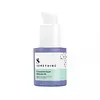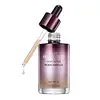What's inside
What's inside
 Key Ingredients
Key Ingredients

 Benefits
Benefits

 Concerns
Concerns

 Ingredients Side-by-side
Ingredients Side-by-side

Water
Skin ConditioningGlycerin
HumectantButylene Glycol
HumectantSqualane
EmollientSaccharomyces Ferment Filtrate
HumectantNeopentyl Glycol Diheptanoate
EmollientCetyl Ethylhexanoate
EmollientDipentaerythrityl Hexa C5-9 Acid Esters
Skin ConditioningBetaine
HumectantPentylene Glycol
Skin ConditioningPolyglycerin-3
HumectantDimethyl Isosorbide
Solvent1,2-Hexanediol
Skin ConditioningIsoamyl P-Methoxycinnamate
UV AbsorberTocopherol
AntioxidantBisabolol
MaskingHydrogenated Olive Oil Unsaponifiables
EmollientAllantoin
Skin ConditioningTromethamine
BufferingAlbatrellus Confluens Extract
HumectantAcrylates/C10-30 Alkyl Acrylate Crosspolymer
Emulsion StabilisingHydrogenated Lecithin
EmulsifyingHydroxypinacolone Retinoate
Skin ConditioningXanthan Gum
EmulsifyingSodium Hyaluronate
HumectantSodium Dilauramidoglutamide Lysine
HumectantSodium Phytate
Ethylhexylglycerin
Skin ConditioningBenzyl Alcohol
PerfumingDehydroacetic Acid
PreservativeWater, Glycerin, Butylene Glycol, Squalane, Saccharomyces Ferment Filtrate, Neopentyl Glycol Diheptanoate, Cetyl Ethylhexanoate, Dipentaerythrityl Hexa C5-9 Acid Esters, Betaine, Pentylene Glycol, Polyglycerin-3, Dimethyl Isosorbide, 1,2-Hexanediol, Isoamyl P-Methoxycinnamate, Tocopherol, Bisabolol, Hydrogenated Olive Oil Unsaponifiables, Allantoin, Tromethamine, Albatrellus Confluens Extract, Acrylates/C10-30 Alkyl Acrylate Crosspolymer, Hydrogenated Lecithin, Hydroxypinacolone Retinoate, Xanthan Gum, Sodium Hyaluronate, Sodium Dilauramidoglutamide Lysine, Sodium Phytate, Ethylhexylglycerin, Benzyl Alcohol, Dehydroacetic Acid
Water
Skin ConditioningBifida Ferment Lysate
Skin ConditioningGlycereth-26
HumectantSorbus Commixta Extract
Skin ConditioningJuniperus Chinensis Xylem Extract
Skin ConditioningBis-PEG-18 Methyl Ether Dimethyl Silane
EmollientButylene Glycol
HumectantGlycerin
HumectantNiacinamide
SmoothingLeuconostoc Ferment Filtrate
AntimicrobialBetaine
HumectantGrifola Frondosa/Ophioglossum Vulgatum Extract Ferment Filtrate
Skin ConditioningLactobacillus/Rice Ferment Filtrate
Skin ConditioningPortulaca Oleracea Extract
Skin ConditioningSodium Hyaluronate
HumectantAnthemis Nobilis Flower Extract
MaskingHydrolyzed Rice Extract
Skin ConditioningSea Water
HumectantCarthamus Tinctorius Oleosomes
EmollientHydrolyzed Extensin
Skin ConditioningAdenosine
Skin ConditioningDaucus Carota Sativa Root Extract
Skin ConditioningVaccinium Angustifolium Fruit Extract
Skin ProtectingBeta Vulgaris Root Extract
Skin ConditioningAronia Arbutifolia Extract
Skin ConditioningBrassica Oleracea Capitata Leaf Extract
Skin ConditioningEchium Plantagineum Seed Oil
Skin ConditioningAscorbyl Tetraisopalmitate
AntioxidantLactobacillus Ferment
Skin ConditioningLactococcus Ferment Lysate
Skin ConditioningManilkara Multinervis Leaf Extract
Skin ConditioningTheobroma Cacao Seed Extract
AntioxidantCassia Alata Leaf Extract
AstringentLaminaria Digitata Extract
Skin ProtectingSaccharomyces Ferment Filtrate
HumectantLactobacillus/Soybean Ferment Extract
Skin ConditioningSaccharomyces/Viscum Album Ferment Extract
Skin ConditioningYeast Ferment Extract
Skin ConditioningPogostemon Cablin Leaf Oil
MaskingPseudoalteromonas Ferment Extract
HumectantCardiospermum Halicacabum Flower/Leaf/Vine Extract
Skin ConditioningHelianthus Annuus Seed Oil Unsaponifiables
EmollientAlpha-Glucan Oligosaccharide
CleansingLimnanthes Alba Seed Oil
Skin ConditioningHydrolyzed Wheat Protein
Skin ConditioningBeta-Sitosterol
Emulsion StabilisingPanthenol
Skin ConditioningHydrolyzed Soy Protein
HumectantUbiquinone
AntioxidantMacadamia Ternifolia Seed Oil
EmollientRetinol
Skin ConditioningCucumis Melo Fruit Extract
Skin ConditioningBiotin
AntiseborrhoeicBrassica Campestris Sterols
EmollientSodium Ascorbyl Phosphate
AntioxidantAmaranthus Caudatus Seed Extract
Skin ConditioningTripeptide-10 Citrulline
Skin ConditioningAcetyl Hexapeptide-8
HumectantCopper Tripeptide-1
Skin ConditioningTripeptide-1
Skin ConditioningAcacia Arabica Stem Bark Extract
Skin ConditioningCholesterol
EmollientGlyceryl Linolenate
EmollientGlyceryl Linoleate
EmollientGlyceryl Arachidonate
EmollientCyclopentasiloxane
EmollientEthyl Hexanediol
SolventDimethicone
EmollientPEG-11 Methyl Ether Dimethicone
EmulsifyingPEG-40 Hydrogenated Castor Oil
EmulsifyingPPG-26-Buteth-26
Skin ConditioningPolysorbate 20
EmulsifyingCarbomer
Emulsion StabilisingGlyceryl Caprylate
EmollientTriethanolamine
BufferingDimethicone/Vinyl Dimethicone Crosspolymer
Skin ConditioningOctyldodecanol
EmollientXanthan Gum
EmulsifyingDipropylene Glycol
HumectantCyclomethicone
EmollientHydrogenated Lecithin
EmulsifyingDisodium EDTA
Dextrin
AbsorbentLauryl Methacrylate/Glycol Dimethacrylate Crosspolymer
Glyceryl Polyacrylate
Dimethiconol
EmollientPropylene Glycol
HumectantCeteth-24
CleansingCholeth-24
EmulsifyingHydroxypropyltrimonium Maltodextrin Crosspolymer
Cetyl Phosphate
EmulsifyingCaprylic/Capric Triglyceride
MaskingLecithin
EmollientPEG-5 Rapeseed Sterol
CleansingBHT
AntioxidantCeteth-3
EmulsifyingCeteth-5
EmulsifyingSilica
AbrasiveTocopheryl Acetate
AntioxidantPhenoxyethanol
PreservativeWater, Bifida Ferment Lysate, Glycereth-26, Sorbus Commixta Extract, Juniperus Chinensis Xylem Extract, Bis-PEG-18 Methyl Ether Dimethyl Silane, Butylene Glycol, Glycerin, Niacinamide, Leuconostoc Ferment Filtrate, Betaine, Grifola Frondosa/Ophioglossum Vulgatum Extract Ferment Filtrate, Lactobacillus/Rice Ferment Filtrate, Portulaca Oleracea Extract, Sodium Hyaluronate, Anthemis Nobilis Flower Extract, Hydrolyzed Rice Extract, Sea Water, Carthamus Tinctorius Oleosomes, Hydrolyzed Extensin, Adenosine, Daucus Carota Sativa Root Extract, Vaccinium Angustifolium Fruit Extract, Beta Vulgaris Root Extract, Aronia Arbutifolia Extract, Brassica Oleracea Capitata Leaf Extract, Echium Plantagineum Seed Oil, Ascorbyl Tetraisopalmitate, Lactobacillus Ferment, Lactococcus Ferment Lysate, Manilkara Multinervis Leaf Extract, Theobroma Cacao Seed Extract, Cassia Alata Leaf Extract, Laminaria Digitata Extract, Saccharomyces Ferment Filtrate, Lactobacillus/Soybean Ferment Extract, Saccharomyces/Viscum Album Ferment Extract, Yeast Ferment Extract, Pogostemon Cablin Leaf Oil, Pseudoalteromonas Ferment Extract, Cardiospermum Halicacabum Flower/Leaf/Vine Extract, Helianthus Annuus Seed Oil Unsaponifiables, Alpha-Glucan Oligosaccharide, Limnanthes Alba Seed Oil, Hydrolyzed Wheat Protein, Beta-Sitosterol, Panthenol, Hydrolyzed Soy Protein, Ubiquinone, Macadamia Ternifolia Seed Oil, Retinol, Cucumis Melo Fruit Extract, Biotin, Brassica Campestris Sterols, Sodium Ascorbyl Phosphate, Amaranthus Caudatus Seed Extract, Tripeptide-10 Citrulline, Acetyl Hexapeptide-8, Copper Tripeptide-1, Tripeptide-1, Acacia Arabica Stem Bark Extract, Cholesterol, Glyceryl Linolenate, Glyceryl Linoleate, Glyceryl Arachidonate, Cyclopentasiloxane, Ethyl Hexanediol, Dimethicone, PEG-11 Methyl Ether Dimethicone, PEG-40 Hydrogenated Castor Oil, PPG-26-Buteth-26, Polysorbate 20, Carbomer, Glyceryl Caprylate, Triethanolamine, Dimethicone/Vinyl Dimethicone Crosspolymer, Octyldodecanol, Xanthan Gum, Dipropylene Glycol, Cyclomethicone, Hydrogenated Lecithin, Disodium EDTA, Dextrin, Lauryl Methacrylate/Glycol Dimethacrylate Crosspolymer, Glyceryl Polyacrylate, Dimethiconol, Propylene Glycol, Ceteth-24, Choleth-24, Hydroxypropyltrimonium Maltodextrin Crosspolymer, Cetyl Phosphate, Caprylic/Capric Triglyceride, Lecithin, PEG-5 Rapeseed Sterol, BHT, Ceteth-3, Ceteth-5, Silica, Tocopheryl Acetate, Phenoxyethanol
 Reviews
Reviews

Alternatives
Ingredients Explained
These ingredients are found in both products.
Ingredients higher up in an ingredient list are typically present in a larger amount.
Betaine is a common humectant (a substance that promotes retention of moisture). It's known to be gentle on the skin and can help balance hydration.
This ingredient is best for improving hydration and soothing irritated skin. Studies also show it helps even out skin tone.
Fun fact: Betaine is naturally created in the skin and body. The kind found within cosmetic products can be either plant-derived or synthetic.
Another name for betaine is trimethylglycine.
Learn more about BetaineButylene Glycol (or BG) is used within cosmetic products for a few different reasons:
Overall, Butylene Glycol is a safe and well-rounded ingredient that works well with other ingredients.
Though this ingredient works well with most skin types, some people with sensitive skin may experience a reaction such as allergic rashes, closed comedones, or itchiness.
Learn more about Butylene GlycolGlycerin is already naturally found in your skin. It helps moisturize and protect your skin.
A study from 2016 found glycerin to be more effective as a humectant than AHAs and hyaluronic acid.
As a humectant, it helps the skin stay hydrated by pulling moisture to your skin. The low molecular weight of glycerin allows it to pull moisture into the deeper layers of your skin.
Hydrated skin improves your skin barrier; Your skin barrier helps protect against irritants and bacteria.
Glycerin has also been found to have antimicrobial and antiviral properties. Due to these properties, glycerin is often used in wound and burn treatments.
In cosmetics, glycerin is usually derived from plants such as soybean or palm. However, it can also be sourced from animals, such as tallow or animal fat.
This ingredient is organic, colorless, odorless, and non-toxic.
Glycerin is the name for this ingredient in American English. British English uses Glycerol/Glycerine.
Learn more about GlycerinHydrogenated Lecithin is created from the hydrogenation of lecithin (a group of phospholipids). Hydrogenation is a chemical reaction between hydrogen and another element.
This ingredient is an emollient and emulsifier. As an emollient, it helps soften skin by trapping moisture within. As an emulsifier, it prevents oil and water ingredients from separating.
Saccharomyces Ferment Filtrate is created from fermenting Saccharomyces, a yeast also known as baker's yeast or brewer's yeast.
As a humectant, Saccharomyces Ferment Filtrate helps draw moisture from the air to your skin to keep your skin hydrated. The humectant properties comes from its beta-glucan content.
Sodium Hyaluronate is hyaluronic acid's salt form. It is commonly derived from the sodium salt of hyaluronic acid.
Like hyaluronic acid, it is great at holding water and acts as a humectant. This makes it a great skin hydrating ingredient.
Sodium Hyaluronate is naturally occurring in our bodies and is mostly found in eye fluid and joints.
These are some other common types of Hyaluronic Acid:
Learn more about Sodium HyaluronateWater. It's the most common cosmetic ingredient of all. You'll usually see it at the top of ingredient lists, meaning that it makes up the largest part of the product.
So why is it so popular? Water most often acts as a solvent - this means that it helps dissolve other ingredients into the formulation.
You'll also recognize water as that liquid we all need to stay alive. If you see this, drink a glass of water. Stay hydrated!
Learn more about WaterXanthan gum is used as a stabilizer and thickener within cosmetic products. It helps give products a sticky, thick feeling - preventing them from being too runny.
On the technical side of things, xanthan gum is a polysaccharide - a combination consisting of multiple sugar molecules bonded together.
Xanthan gum is a pretty common and great ingredient. It is a natural, non-toxic, non-irritating ingredient that is also commonly used in food products.
Learn more about Xanthan Gum